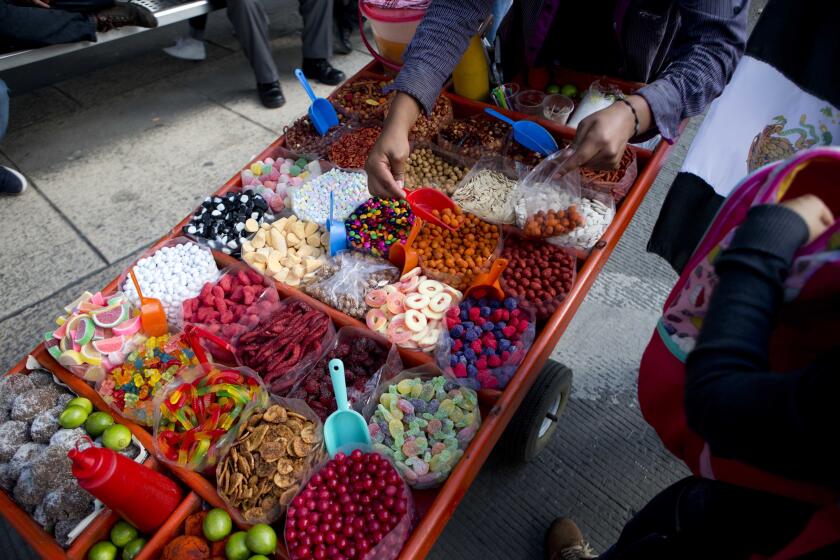Chains Promote Pesticide-Free Grapes
Produce sales have increased appreciably at Ralphs Grocery Co., since the supermarket chain introduced a private testing program to monitor pesticide residue on fruit and vegetables last month.
In fact, a recent promotion for pesticide-free grapes was the most successful of its kind in the chain’s history, company officials said recently.
“We have had a 16% to 17% increase in (overall) sales of produce since we started the NutriClean program,” said Byron Allumbaugh, chairman and chief executive officer of the 129-store chain. Allumbaugh’s remarks came during a lengthy presentation for Los Angeles-area financial analysts on the company’s plan to issue $400 million in high-yield bonds.
NutriClean, an Oakland-based firm, randomly selects samples from arriving produce shipments at Ralphs warehouse and sends the food to an independent laboratory for chemical analysis.
The produce is then tested for the presence of potentially harmful pesticides. Eventually, Ralphs will purchase produce only from those suppliers whose crops have consistently demonstrated minimal amounts of chemical residue, according to the lab tests.
NutriClean also monitors the agricultural chemical usage of California growers who volunteer for the program. The benefit of participation is that those fruit and vegetable items that contain “no detectable pesticide residues” at harvest are certified and labeled as such.
The NutriClean certification has apparently become a powerful sales tool for food stores. In fact, grapes recently designated as virtually free of chemicals were a very successful item for Ralphs.
“We sold 1 million pounds of grapes in 7 days,” Allumbaugh said. “We could have bought grapes cheaper and sold them at 59 cents a pound. But we bought the pesticide-free fruit and sold it at 79 cents. . . . It was the largest single sale of produce in the history of the company.”
Public opinion surveys have found repeatedly that about 75% of consumers polled are concerned about the presence of agricultural chemicals in food.
And Ralphs has not been alone in offering shoppers an option when it comes to pesticides and produce.
Recently Vons Grocery Co. also heavily advertised its sale of organically grown grapes. In this case, a farming method was employed that did not require use of chemicals on the fruit. Vons is indirectly addressing consumer concerns by advertising that the company is “obsessed with quality” when it comes to produce.
Reviewing the Threat--A decidedly cautious view of the nation’s pesticide problem recently appeared in the Journal of the American Medical Assn.
The article is noteworthy because it’s at odds with prevailing opinions held by numerous consumer groups and members of Congress that agricultural chemicals pose a serious threat to public health.
The article, a review of current scientific research, found that only two of the pesticides currently in use actually cause cancer in humans.
All other agricultural compounds previously implicated as health hazards have only been proven to be cancer agents in laboratory animals. And the report goes on to state that these types of animal tests are “not reliably predictive” of human cancers.
“Except for the chemicals arsenic and vinyl chloride, there is great uncertainty about the human cancer-causing potential of hundreds of other pesticidal agents,” the article stated.
Though somewhat flawed as predictors, animal studies are nevertheless used as the basis for determining whether a chemical poses a threat to the public. And, based on this data, the federal government regulates all those compounds predicted to cause more than four additional cancers per 1,000 persons before the chemicals are put in use, according to the report.
Another problem in determining the pesticide threat, the article states, is that those research projects that have looked at the reasons for cancer in humans--a process known as an epidemiology--often “fall short of establishing definite links between chemical exposure and cancer in humans,” the review found.
The journal article was commissioned by the American Medical Assn. to alert physicians to the potential dangers of agricultural pesticides.
The review does concede that farmers, the group with the highest exposure to pesticides, do have an increased risk of cancer.
“Numerous studies now suggest that today’s farmers could have an increased risk of developing certain types of cancers, and the question is whether pesticides play a role,” the report said.
However, the article did not downplay the pesticide threat. It proposed further studies of the long-term effect of pesticide exposure and urged the Environmental Protection Agency to eliminate known chemical hazards for agricultural workers.
Eat More Produce--Pesticides notwithstanding, a California state senator has introduced a resolution in the Legislature calling for consumers to greatly increase their consumption of fruits and vegetables as a means of reducing cancer.
The bill, sponsored by Sen. John Garamendi, (D-Stockton), is awaiting action in the Assembly after its passage in the Senate. The legislation urges Californians to increase their per-capita consumption of fruit to 500 pounds annually by the year 2000.
The increase, almost double current rates, is expected to help reduce intake of other foods, such as fats, and thus reduce cancer risks, according to the legislation.
The National Cancer Institute estimated that as many as 35% of the deaths caused by cancer can be linked to diet.
“A doubling of the current consumption of fruits and vegetables in the typical California diet (is) one of the ways to reduce the risk of cancer,” the Garamendi resolution states.
There is little likelihood that the Garamendi resolution will meet with much opposition when it comes up for an Assembly vote, especially considering that California leads the nation in the production of fruit and vegetables. As such, the state’s agricultural interests would greatly benefit if consumers increased produce consumption by 100%.
More to Read
Eat your way across L.A.
Get our weekly Tasting Notes newsletter for reviews, news and more.
You may occasionally receive promotional content from the Los Angeles Times.










